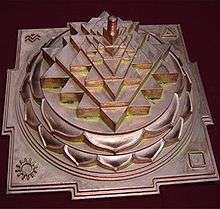Shri Vidya

Śrī Vidyā (also spelled "Shri" or "Shree" Vidya. विद्या (IAST: vidyā) is "knowledge, learning, lore, science".[1]) is a Hindu Tantric religious system devoted to the Goddess as Lalitā Tripurasundarī ("Beautiful Goddess of the Three Cities"), Bhuvaneshvari etc. A thousand names for this form of Devī are recited in the Lalitā Sahasranāma, which includes Śrī Vidyā concepts.[2] The sect accepts and aims to provide both material prosperity and self-realisation. It has an extensive literature.[3] Details of belief vary in different texts but the general principles are similar to those found in Kashmir Shaivism.[4] There are various schools, including the so-called left-handed and right-handed practice. Initiation must be from a guru. Many Sri Vidya mantras are available in print but they are often considered more potent in the context of the guru's initiation.There is a very popular saying among Sri Vidya tradition is that one has to be verily Shiva himself or in one's last birth to get Sri vidya. Since we are not Shiva, it has to be the last birth or when we get it, it becomes our last birth[5] and One can worship Lalitha only if she wishes us to do so.
In the principally Shakta theology of Śrī Vidyā the goddess is supreme, transcending the cosmos that is her manifestation.[6] She is worshiped in the form of a mystical diagram (Sanskrit: yantra), a central focus and ritual object composed of nine intersecting triangles, called the Sri Yantra or śrīcakra[7] The Meru Chakra is a three-dimensional form of this, made of rock crystal or metal, often a traditional alloy of silver, antimony, copper, zinc and pewter that is held to enhance the flow and generation of its beneficial energies, covered in gold. Subhash Kak argues that this is the yantra described in the Śvetāśvatara Upanisad.[8]
Mantras are believed to reveal the unity of the deity, the guru and initiate and the mantra or sound syllable Itself. The first mantra given to initiates is the Bala Tripurasundari Mantra. Here the Goddess is visualized as a small child. The next level mantra is the fifteen-lettered Panchadasi or Panchadasakshari Mantra. A higher mantra is the sixteen-lettered Shodasi or Shodashakshari Mantra.
Major texts
- Sharada Tilakam
- Shubagama Panchagam
- Prapanchasara
- Saundarya Lahari
- Tripura Rahasya
- Sri Vidya Ratnakara (Karapatra Swamy Varnasi)
Devi Khadgamala Stotram
This describes the various deities in the Sri Yantra.
Notes
- ↑ Apte 1965, p. 857.
- ↑ For influence on the Lalitā Sahasranāma and a brief summary of some Śrī Vidyā practices see: Sastry 1986, pp. vii-ix.
- ↑ Bhattacharyya 1999, p. 329.
- ↑ Flood 1996, p. 188.
- ↑ "SriVidya the secret path". Retrieved May 12, 2015.
- ↑ For goddess as supreme and beyond the manifest cosmos, see: Flood 1996, p. 188.
- ↑ Flood 1996, pp. 187–188.
- ↑ http://ikashmir.net/subhashkak/docs/SriChakra.pdf Subhash Kak, The Great Goddess Lalitā and the Śrī Cakra. Brahmavidyā: The Adyar Library Bulletin, vol. 72-73, pp. 155-172, 2008-2009
References
- Apte, Vaman Shivram (1965), The Practical Sanskrit Dictionary (Fourth revised and enlarged ed.), Delhi: Motilal Banarsidass Publishers, ISBN 81-208-0567-4
- Bhattacharyya, N. N. (1999), History of the Tantric Religion (Second revised ed.), New Delhi: Manohar, ISBN 81-7304-025-7
- Dempsey, Corinne G. (2006), The Goddess Lives in Upstate New York: Breaking Convention and Making Home at a North American Hindu Temple (first ed.), New York: Oxford University Press, ISBN 978-0-19-518729-8
- Dev, K. V. (editor) (1996), The Thousand Names of the Divine Mother, San Ramon, California: Mata Amritanandamayi Center, ISBN 1-879410-67-2
- Flood, Gavin (1996), An Introduction to Hinduism, Cambridge: Cambridge University Press, ISBN 0-521-43878-0
- Joshi, L. M. (1998), Lalitā Sahasranāma, New Delhi: D. K. Printworld (P) Ltd., ISBN 81-246-0073-2
- Sastry, R. Ananthakrishna (1986), Lalitāsahasranāma, Delhi: Gian Publishing House
- Tapasyananda, Swami (1990), Śrī Lalitā Sahasranāma, Mylapore, Chennai: Sri Ramakrishna Math, ISBN 81-7120-104-0
- Melanathuru, Venkata Subrahmanyam, Śhrī Vidya Upasana, Nellore, Andhra Pradesh - 9849120534